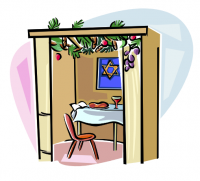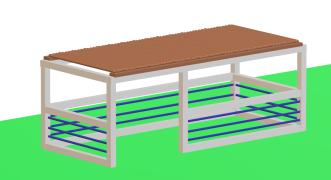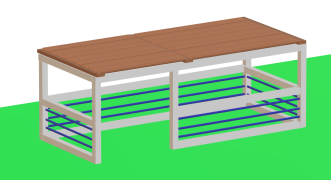Materials to use for S'chach
From Halachipedia
This is the approved revision of this page, as well as being the most recent.
One of the most critical parts of the Sukkah is the S'chach, the natural covering of the Sukkah, which provides the shade for the Sukkah.[1]
Basic Requirements of S'chach
- There are three conditions for Schach to be valid. It must be made from a material that grows from the ground, is detached from the ground, and is impervious to impurity (see further for examples). [2] All of these examples are biblical invalidations.[3]
Grow from the Ground
- In order for Schach to be kosher it must grow from the ground.[4]
- Metal, dirt, and animal hides are unfit for S'chach as they do not grow from the ground.[5]
- Nylon or plastic curtains are not kosher for sechach because they do not grow from the ground.[6] Neither is glass for the same reason. [7]
- Fresh plants that will dry up and fall down in the middle of Sukkot are unfit even for the beginning of Sukkot. [8] Similarly, if the plants cover a majority while they are fresh and they will dry up in the middle of Sukkot and cover a minority of the Sukkah that is also an issue even for the beginning of Sukkot.[9]
Completely Changed Form,
- Material that is grown from the ground but is completely changed from its original form is unfit. [10] For example, paper and cardboard are unfit for Schach. [11] This is a rabbinic invalidation.[12] One may however use paper for decorating the sechach.[13]
- One is permitted to paint or color the sechach to make it look more beautiful.[14]
Attached to the Ground
- Branches attached to a tree which is still attached to the ground is not fit for schach. Therefore, if one builds a Sukkah underneath a tree, using the branches as sechach and then decided to detach them from the tree, one must shake each branch by lifting and placing back down. Otherwise it is not kosher, as this is a problem of taaseh vilo min ha'asuy. [15]
Impervious to Impurity
- One may not use food as Schach since it is susceptible to impurity.[16]
- One may use spices which are only meant to be smelled or flowers which are only meant as decoration as Schach since they are impervious to impurity.[17]
- Even things that only can become tameh midirabanan are not kosher for schach.[18]
Bamboo Mats
- Bamboo mats made for S'chach, which are 3x2 meters, are fit for S'chach according to most poskim.[19] Some poskim are strict and do not allow using mats from bamboo or reeds for schach.[20]
- Regarding the use of hemp string to tie the bamboo for the schach together, most poskim are lenient.[21] Some are concerned when the strings used to tie the mats are spun and others aren't.[22]
- Some poskim (Star-K) recommend using monofilament nylon strings to hold the bamboo together.[23]
- Other poskim (Badatz Edah Charedit) recommend using strips of natural material to hold the bamboo together.[24]
Thickness of the Schach
- The S'chach should be made so that there is a majority of shade and minority of sunlight that's let through the S'chach. If there's an equal amount of shade and sun in the actual S'chach it's unfit but if there's an equal amount of shade to light that shines on the floor of the Sukkah it's fit.[25]
- The S'chach should be thin enough that one can see the large stars through the S'chach.[26]
- If one made the S'chach very thick so that one can't see the stars nonetheless it's fit. However, if it's so thick that when it rains a lot water won't come in then some poskim hold that it's unfit, unless there's no way to remove some S'chach in which case one may rely on the lenient opinions.[27] If one does remove some sechach, he does not need to shake the rest of the sechach in order of avoid taaseh vilo min haasuy.[28]
- If one made the S'chach very thin so that there's patches of empty space it's fit only if (1) there's no area of empty space larger than 3 Tefachim and (2) there is a majority of shade and minority of sunlight (counting the entire area of the S'chach). Even if it's an acceptable Sukkah, nonetheless, if there's a patch of 7x7 Tefachim which has more sunlight than shade one may not sit in that area.[29]
Invalid Schach and Airspaces
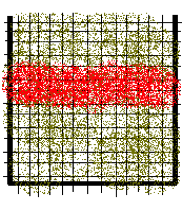
area beneath invalid schach is valid[30]
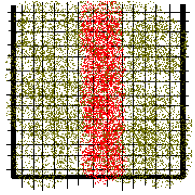
invalid[31]
- If there are less than 3 tefachim of invalid schach in middle of the sukkah, the sukkah is valid and one may sit underneath that invalid schach. If there are between 3 and 4 tefachim of invalid schach, the sukkah is valid, but one shouldn’t sit underneath that schach.[32]
- 3 tefachim of airspace or 4 tefachim of invalid schach may invalidate the sukkah (see pictures on side). Anything less will not.[33]
- One can’t sit underneath an airspace the size of one’s head or body[34] even if it is less than 3 tefachim. Also, one can’t sit underneath an airspace that goes across the entire length of the sukkah even if it is less than 3 tefachim.[35]
- If there is an airspace of 3 tefachim along a wall of the sukkah that wall isn’t considered part of the sukkah. If less than two and a half walls remain, the sukkah is invalid.[36]
Schach Held Up by Unfit Items
- It's preferable not to put the S'chach directly on top of walls which are made out of material that's unfit for S'chach.[37] According to most leading authorities, however, it's permissible to place S'chach on top of a material that's fit for S'chach which is in turn held up by something that's unfit for S'chach. Therefore, if one has a metal frame one should place wooden planks on the frame and then S'chach on top of it.[38] After the fact, if the schach was placed directly on metal, it is kosher.[39]
- There is a dispute among the poskim whether maamid applies to anything which is invalid for schach but isn't mekabel tumah, such as plastic that doesn't grow from the ground but isn't mekabel tumah. Many are strict to consider it maamid, but some are lenient.[40]
- One should ideally avoid tying the schach down with a material that would not serve as kosher schach if the schach would be unable to withstand regular wind independently.[41] However, many poskim permit in all circumstances to tie down schach with material that is only invalid as schach mi’derabanan, such as natural twine.[42]
- Using zip-ties to tie down the schach so that they don't blow away is a problem if otherwise the schach would blow away in a normal wind. After the fact, the sukkah is still acceptable, though it should be avoided. If the schach is secure enough that it'll stay for a normal wind then using the zip-ties is totally fine since it is only adding extra security to avoid uncommon winds.[43]
- One shouldn't use schach with a foul odor or whose leaves are falling off because there is a concern that the person may come to leave his sukkah because of the smell or the leaves falling on him.[44] After the fact, it is valid.[45]
- Some poskim hold that placing wooden beams on top of a metal frame and schach on top is considered indirect maamid (maamid d'maamid) and is kosher (Picture #1).[46] Others hold that it is only permitted if the wooden beams are significantly supporting the schach such that if they were removed the schach would fall (Picture #2).[47]
Sukkah Built Underneath a Tree or House
- One must ensure that one's Sukkah is under the open sky and not beneath a tree, roof of a house, or a porch. (For details about after the fact see the footnote.) [48]
- If one built a sukkah under a tree or a house which would render it unfit, and then removed the branches or the roof to make it kosher, this isn't a problem of taaseh vilo min ha'asuy as the problem was never in the schach itself. [49]
- Branches near one’s sukkah but not directly above it don’t impact the validity of the sukkah even if they provide it shade. [50]
- A sukkah built under clothes-lines or electric/phone lines, even if there isn't a space of 3 Tefachim between each one, is still kosher, even if clothing is on the lines. [51]
- One may hang lights from the S'chach even if they hang below 4 Tefachim from the S'chach. [52]
S'chach Moved Due to Inclement Weather
- If a strong wind blew the schach higher than 3 Tefachim above the sukkah and then fell back down, even though since it happened automatically it wasn't put down for the sake of shade, the sukkah is kosher since it was originally placed in a kosher manner. [53]
- If snow falls and solidifies on top the schach the sukkah is still kosher and one can recite a bracha of leshev basukkah.[54]
Positioning of the S'chach
Links
- Yalkut Yosef Hilchot Sukkah (Hebrew 5776)
- Pasul Schach by Rabbi Zvi Sobolofsky
Sources
- ↑ Rashi (Sukkah 2a s.v. delo) writes that the word Sukkah is derived from the word Schach which is the primary part of the Sukkah.
- ↑ The Mishna (Sukkah 11a) indicates that Schach must be grown from the ground, detached from the ground, and impervious to impurity. The source for these requirements according to the gemara (Sukkah 12a) is the pasuk (Devarim 16:13) which says that the Schach should be made from the materials of the granary and winery. See also Rashi (Sukkah 11a s.v. pesula). Rambam (Sukkah 5:1) and Shulchan Aruch 629:1 codify this as halacha. Yalkut Yosef Moadim page 123 and Chazon Ovadia Sukkot page 14 concur.
- ↑ Biur Halacha 629 s.v. Tzomech
- ↑ Shulchan Aruch 629:1
- ↑ Shulchan Aruch and Rama 629:1, Yalkut Yosef Moadim page 123, Chazon Ovadia Sukkot page 14
- ↑ Chazon Ovadia Sukkot pg. 15, Shu"t Shevet Halevi 4:57
- ↑ Chazon Ovadia Sukkot pg. 15, Bikkurei Yaakov 632:7
- ↑ Rama 639:12, Magen Avraham 629:13
- ↑ The Levush 629:12 writes that if the fresh plants cover a majority only while they are fresh and they will dry up and cover a minority of the Sukkah that is an issue. However, the Pri Megadim (E"A 629:13) questions him and points out that perhaps this is only a rabbinic concern. Kaf Hachaim 629:73 is concerned for the Levush.
- ↑ Rambam (Sukkah 5:4)
- ↑ Chazon Ovadia Sukkot pg. 16, Yalkut Yosef 629:14. Minchat Shlomo 112 entertains both the possibility that paper is unfit because it is changed from its original form and because perhaps it is susceptible to impurity.
- ↑ Mishna Brurah 629:12
- ↑ Chazon Ovadia Sukkot pg. 16 Shu"t Minchat Shlomo 3:151
- ↑ Chazon Ovadia Sukkot pg. 32, Halichot Shlomo pg. 130
- ↑ Shulchan Aruch 626:2, Yalkut Yosef Moadim page 123, Chazon Ovadia Sukkot page 33.
- ↑ Rambam (Sukkah 5:3), Chazon Ovadia Sukkot pg. 19
- ↑ Rav Ovadyah Yosef in Chazon Ovadia (Sukkot, p. 23)
- ↑ Chazon Ovadia Sukkot pg. 21
- ↑ Rav Ovadia Yosef (Chazon Ovadyah Sukkot pg 25-6), Rav Moshe Feinstein (Mesoret Moshe v. 1 p. 219), Rav Shlomo Zalman Auerbach (Halichot Shlomo pg 128), Az Nidbaru (2:66, 12:35), Rav Wosner (Sh"t Shevet HaLevi 6:74), and Rav Herschel Schachter (min 78-79:30) are all lenient to allow using bamboo mats. However, Rav Elyashiv (Kovetz Teshuvot 1:63) holds that it is invalid.
- Chazon Ovadia (p. 23) writes that bamboo mats that are strung together with organic materials or cotton are valid schach. He reasons that it is similar to the case of the mat which is used only for schach and is recognizable for that purpose. Therefore, the mats aren’t susceptible to impurity. Also, it isn’t similar to a roof as there are spaces between the planks and can be folded up. Rav Shlomo Zalman Auerbach (Halichot Shlomo p. 128) and Rav Hershel Schachter (עניני יוה”כ וסוכות, min 78-79:30) agreed.
- Tzitz Eliezer 10:29 writes that one shouldn't use reed or straw mats for Schach. The reasoning is that the mats are sometimes used for sitting, sleeping, or containing items in which case they are impure. This would be a biblical invalidation. He adds that even if its designated to be used for schach there would be a rabbinic prohibition lest it be confused with those that are are unfit. Additionally, sometimes it is used as for roofing in which case they would be unfit as it looks like a real roof.
- Here is a breakdown of the issues involved: (1) Are the mats made to be slept upon? Tzitz Eliezer is concerned that the mats are made to be slept upon even in Israel, while Az Nidbaru and Rav Ovadia aren't concerned because they hold that in fact people in Israel do not sleep on these bamboo mats made for schach. Also, the bamboo mats are made to be larger the size of a bed are kosher since it isn't normal to make them for people to sleep upon (Rav Ovadia, based on Bikkurei Yakov and Mishna Brurah (Shaar Hatziyun 629:24)). (2) Is there a concern that people will think that people made the mats for sleeping (marit ayin)? Tzitz Eliezer is concerned for this issue, but Rav Ovadia is not concerned because firstly it is not used for sleeping upon in Israel (according to his view) and this concern of marit ayin is subject to debate. Tzitz Eliezer holds that everyone agrees that marit ayin is an issue, while Rav Ovadia argues that Shulchan Aruch holds that there is no concern for marit ayin as he rules like the Rid unlike the Rosh. (3) Is it likely people will assume if you can use mats for schach they can also use a real home roof for a sukkah? Rav Elyashiv argues that since the pieces of the mat are strung together altogether they become one piece that is wider than 4 tefachim which would make it invalid schach, since it could be used for roofing according to chazal (gezerat tikra). However, Rav Ovadia argues that the mats aren't used for roof nowadays and also since it rolls up it isn't similar to a large wooden board. Shevet Halevi also writes this second argument. (4) The mats are strung together by material which is invalid for schach (maamid). Rav Wosner writes that this issue is an issue if without that string the bamboo would fall down. However, if the bamboo wouldn't fall down even if the string were removed it isn't an issue of maamid and is valid. Star-K writes that a person should put up the mats so that the bamboo pieces are perpendicular to the beams or walls, so that the two ends of the bamboo pieces are resting on beams or walls. That is opposed to setting up the bamboo parallel to the walls and beams such that the middle bamboo pieces aren't resting on anything. (5) Rav Ovadia Yosef (Chazon Ovadia p. 29) and Rav Nissim Karelitz (Chut Shani p. 216) hold that there's no concern that schach mats are invalid since a person might leave them on top of his sukka to dry out (see Shulchan Aruch O.C. 629:15).
- ↑ Rav Elyashiv (Kovetz Teshuvot 1:63), Rabbi Morechai Willig (Shiur Sukkah 28, min 38-39), and Rav Nissim Karelitz (Chut Shani, Sukkot p. 214) hold that the mats shouldn’t be used since they might have been made for sleeping on since they’re produced in China or far east.
- ↑ Regarding the hemp string used to tie the bamboos together, Rav Ovadia (Chazon Ovadia p. 30) writes that using string made from organic material for schach is only invalid rabbinically according to the Rambam if it is altered from its natural form (or according to the Raavad because it is useable for clothing). Since it is only a rabbinic issue, Rav Ovadia reasons that it is permitted to use it in order to hold up or hold together the schach. See the next footnote regarding maamid regarding items that are rabbinically invalid. Accordingly, Rav Schachter (“Inyonei Sukkos” on Yutorah.org min 60-4) permitted using hemp or cotton strings to hold together the bamboo mats.
- ↑ Rashi Shabbat 64a s.v. yachol holds that any string that the fibers of which are spun by themselves are mekabel tumah. The Rambam (Sukkah 5:4, Kelim 22:1) disagrees and the Meiri 64a s.v. kilki explains the dispute in how to learn the gemara. The Shulchan Aruch (Bet Yosef 629:5) follows the Rambam as does the Mishna Brurah, but the Shaar Hatziyun 629:20 notes Rashi. Rav Moshe Feinstein (Igrot Moshe 1:177) in discussing venetian blinds also seems to be strict for Rashi. Rav Heinemann is strict for Rashi. Rav Hershel Schachter is not concerned for Rashi since the Shulchan Aruch followed the Rambam.
- ↑ Star-K
- ↑ Badatz Edah Charedit
- ↑ Shulchan Aruch 631:1 and 4
- ↑ Shulchan Aruch 631:3, Chazon Ovadia Sukkot pg. 24. The Pri Megadim E”A 631:11 writes that it is sufficient as long as the stars are visible from one point in the sukkah.
- ↑ Shulchan Aruch 631:3, Mishna Brurah 631:6.
- The Mordechai Sukkah 1:732 writes that a sukkah that is so thick that it doesn't allow rain to fall in, according to Rashi is kosher, but not according to Rabbenu Tam.
- Shulchan Aruch HaRav 631:5 holds that it is not kosher.
- Birkei Yosef 631:2 holds that although it is not ideal, it is still kosher. Chazon Ovadia Sukkot pg. 24 writes that we can rely on the opinion of the Shulchan Aruch and even recite a beracha in such a sukkah but it is preferable to remove some sechach in such a scenario (and if it is shabbat or yom tov to ask a non-Jew to do so for you.
- Mishna Brurah 631:6 concludes that if there's no way to remove some S'chach one may rely on the lenient opinions.
- ↑ Chazon Ovadia Sukkot pg. 37, Shaar Hatziyun 631:5, Eliya Rabba 631:4, Mateh Ephraim 626:17
- ↑ Shulchan Aruch 631:2 and 4 rules that if altogether there's a majority of shade and minority of sunlight and there's no open space of 3 Tefachim it's fit. Rama 631:2 adds that some are strict if there's an area of 7x7 Tefachim which has more sunlight than shade. The Aruch HaShulchan 631:5 and Mishna Brurah 631:4 writes that in such an area one may not sit. Mishna Brurah adds that if there's such a patch that breaks up one of the walls so that there's only 2 walls left then it puts the whole sukkah into question.
- ↑ The invalid schach invalidates the entire area above the invalid schach. However, the area below is valid as long as there are 3 walls surrounding 7x7 tefachim of valid schach (Mishna Brurah 632:14-5).
- ↑ This sukkah is invalid because the invalid schach in the middle splits the sukkah in two. Therefore, each half only has 2 walls which is insufficient (Mishna Brurah 632:2).
- ↑ S”A 632:1, Rama 632:2, Mishna Brurah 632:3
- ↑ Shulchan Aruch and Rama O.C. 632:2
- ↑ While the Rama 632:2 writes “rosho ve’rubo” the Mishna Brurah 632:12 quotes the Ran and Ritva who hold either “rosho” or “rubo.”
- ↑ S”A 632:2, Mishna Brurah 632:12
- ↑ S”A 632:2, Biur Halacha 632 s.v. avir
- ↑ Magen Avraham 629:9, Mishna Brurah 630:59, Chazon Ovadyah (Sukkot pg 44)
- The Mishna (Sukkah 21b) cites Rabbi Yehuda who holds that one may not use bed boards for sukkah walls unless the schach is held up by something else. The Gemara records a dispute regarding Rabbi Yehuda’s reason; either it is because the sukkah isn’t considered a suitable dwelling without additional poles for support or because the schach is being held up by something that is susceptible to tumah. The Raavad (Sukkah 10a), Ramban (Milchamot Sukkah 10a), and Ran (Sukkah 10a s.v. Matnitin) understand that the primary reason for Rabbi Yehuda is that one may use items that are susceptible to tumah to hold up the schach as a gezerah that one may come to use it as schach itself.
- The Rosh (Sukkah 2:1) writes that the halacha follows Rabbi Yehuda and his reasoning is that when the schach is placed on top of a bed, there is only a small area between the schach and the bed, which isn’t suitable for use. The Trumat HaDeshen (responsa 91), Tur and S”A 630:13 agree.
- Lastly, the Baal HaMeor (Sukkah 10a) holds like the rabbanan and we shouldn’t be concerned with either reason above. Hashlama holds that Rambam does not hold of maamid, as is evident from Pirush Mishnayot. Shaar Hatziyun 630:60 notes this is the opinion of Rambam as hold as Maharitz Gayitz and Rid.
- Even according to the first group of rishonim there are two limitations. The Ran writes that it is permitted to place schach on top of stone walls because no one uses stones for schach and no one will make a mistake to think that it is kosher. Additionally, the Ramban writes that placing schach on top of poles on top of a bed is permitted since the bed is acting as a ground for the sukkah and isn’t directly supporting the schach.
- What’s the halacha? Since Shulchan Aruch O.C. 630:13 holds like the Rosh, it would seem to be clear that is permitted to use items that are susceptible to tumah to hold up the schach. However, Shulchan Aruch O.C. 629:7 has a doubt whether it is permitted to place a ladder on top of schach. The Magen Avraham 629:9 suggests an explanation in which he forbids using a ladder that is susceptible to tumah lechatchila and would only permit it after the fact. Mishna Brurah 630:59 writes that it is permitted, but it is proper to be concerned for the opinions who are strict.
- ↑ Mishna Brurah 629:26, BeYitzchak Yikra (Rav Nevinsal) on that Mishna Brurah quoting Rav Shlomo Zalman Auerbach, Rav Ovadia Yosef (Yabia Omer 10:46 and Chazon Ovadyah Sukkot pg 44), and Or Letzion 4:24:8 are lenient unlike the Chazon Ish 143:2-3. Rav Hershel Schachter (62:30-66:15) also seems to be lenient. See Chelkat Yaakov 3:127, Minchat Shlomo 2:55, and Moadim U'zmanim 1:82.
- The Magen Avraham 629:9 permits using metal nails to support the poles of the sukkah since they don’t directly support the schach. For example, the Bikkurei Yacov 629:15 writes that it is permitted to place schach on top of wooden poles on top of walls which are susceptible to impurity. The Chazon Ish (O.C. 143:2) argues since we can’t distinguish between different layers of schach and simply state the top layer of kosher schach is supported by another layer that is in turn supported by an item that is susceptible to tumah. Rav Schachter (“Inyonei Sukkah”, min 44-6, 62-4) noted that although the Chazon Ish’s argument is reasonable, the minhag follows the Magen Avraham and allows placing schach on top of planks on top of a metal frame. Halichot Shlomo 8:10, Or Letzion 4:24:8, and Yabia Omer 10:46 hold maamid d'maamid is permissible unlike Chazon Ish.
- ↑ Mishna Brurah 629:22 and 630:58
- ↑ Maharil Diskin 56 is lenient about this since Shulchan Aruch only mentions maamid regarding items are mekabel tumah and doesn't mention it for any other invalid schach. Rav Henkin (Gevurat Eliyahu siman 164, p. 301) is lenient on things that don't grow from the ground and aren't mekabel tumah. In fnt. 1185 he writes that Rav Moshe Feinstein agreed with Rav Henkin about this. However, Bet Hasho'eyva (Makom Hareuy Lsukkah n. 16) is strict about maamid with something that doesn't grow from the ground even though it isn't mekabel tumah. Kaf Hachaim 627:40 quotes this and Ginat Veradim who seems to be lenient on this. Additionally, Rav Shlomo Miller (Shoshat Yisrael p. 16) is strict about bamboo mats made with plastic threads because plastic doesn't grow from the ground. Rivevot Efraim 8:242:2 and Rav Schachter (“Inyonei Sukkos” on Yutorah.org min 60-4) are strict. Halichot Shlomo p. 128 fnt. 14 quotes that Rav Shlomo Zalman thought the Maharil Diskin's leniency is strange since it is against the Ran and Magen Avraham but the Meiri does say it. Chazon Ovadia p. 47 quotes this whole discussion and notes that the Itur and Meiri 22 are lenient about maamid with something that doesn't grow from the ground but also wonders why the Maharil Diskin was lenient since the Ran and most other rishonim were strict about this.
- ↑ Be’tzel Ha’Chochma 5:44
- ↑ Ritva (Sukkah 11b) writes that it is permitted to use a material that is only rabbinically invalid in order to hold up the schach since the entire issue of maamid is only a gezerah, so the rabbis would never have instituted a gezerah l’gezerah. Gra 630:1 quotes the Gra as does the Biur Halacha 630:1. Rav Vosner (Kovetz Mbeit Levi v 4, pg. 23), Rav Ovadia Yosef (Chazon Ovadia p. 24-5, 30), Or Letzion 4:24:9, and Rav Schachter all follow the Ritva and allow maamid with a pasul derabbanan. Rav Schachter (“Inyonei Sukkah”, min 44-6, 62-4) agreed, though he questioned it because this seems to fall into the category of a double d'rabbanan and not a gezerah l’gezerah. This is reiterated in another shiur ("Inyonei Succos 5781" min 22-28). However, Derech Hachaim 170:4, Mishna Brurah 629:25, and Chazon Ish 143:2 hold that maamid with something that is mekabel tumah midrabbanan is a problem. See Piskei Teshuvot 629 fnt. 29 who deals with the seeming contradiction in Mishna Brurah.
- ↑ Rav Nissim Karelitz (Chut Shani p. 210) writes that a person should not tie down his schach with zip ties. But if his schach would have stayed in a normal anyway without the zip ties it is fine to use them because of an abnormal wind. Piskei Teshuvot 629:11 agrees and also quotes this from Avnei Yishfeh 1:120. Rav Aryeh Lebowitz explains that the only issue of zip ties is maamid since it enables the schach to be held in place and not blow away. The entire issue of maamid is rabbinic and initially an issue but not after the fact. If the schach would be able to withstand normal winds then you can add the zip ties to add security so it doesn't blow off in an uncommon wind (ruach sheino metzuya). Star-K and OU come to the same conclusion in terms of it only being an issue if it is going to blow away in a normal wind.
- ↑ Rambam (Sukkah 5:1), Shulchan Aruch O.C. 629:14, Chazon Ovadia pg. 30, Magen Avraham 629:15, Kaf Hachaim 639:81
- ↑ Rambam (Sukkah 5:1)
- ↑ Drishu 629:20 quoting Kaf Hachaim 626:42, Mikrei Kodesh 1:21 as well as Chut Shani p. 210 and Kehilat Yakov 18 in understanding the Magen Avraham. This is also evident in Chazon Ovadia p. 46
- ↑ Drishu 629:20 quoting Rav Shlomo Zalman Auerbach (Minchat Shlomo 2:55 and Halichot Shlomo ch. 8 fnt. 37) and Rav Elyashiv (Ashrei Ish 3:25:25)
- ↑ Rama 626:1 writes that in all cases one should avoid building one's sukkah under a tree or roof. Mishna Brurah 626:1 and Aruch HaShulchan 626:1 explain that it's best to build the Sukkah under the open sky. This is also the opinion of Chazon Ovadyah (Sukkot pg 11) and Yalkut Yosef Moadim page 125. However, after the fact, Aruch HaShulchan 626:1 writes if it's built under a roofed area it's unfit, but if it's built under a tree there is a discussion about when it is fit. Shulchan Aruch 626:1 (according to Beiur Halacha s.v. VeYesh, Mishna Brurah 626:10 and 11) rules that a sukkah under branches of a tree is fit only if it fits three requirements (See Shulchan Aruch with Mishna Brurah 626:10 and 11). (1) Among the branches of the tree there is majority of sun and minority shade (2) there is less than four Tefachim of tree branches over the schach, and (3) there is a majority of shade from the kosher schach and a minority of shade even without the tree branches (and even so the sachach under the tree branches itself is unfit but the rest of the sukkah is fit).
- ↑ Chazon Ovadia page 33.
- ↑ Biur Halacha 626:1 s.v. tachat ha’ilan
- ↑ Yalkut Yosef Moadim page 125, Chazon Ovadia Sukkot page 69.
- ↑ Chaye Adam 146, Mishna Brurah 627:15, Nitei Gavriel (Sukkot 26:4)
- ↑ Sh"t Shevet Halevi 10:100
- ↑ Sh"t Ginat Veradim 4:7, Shaarei Teshuva 626:1, Moed Likol Chai 21:20, Bikkurei Yaakov 626:7, Yalkut Yosef Moadim page 125 and Chazon Ovadia Sukkot page 37. Aruch Hashulchan 629:2 however only permits saying a beracha if the schach is still greater than the snow.
- ↑ Shulchan Aruch 631:10
}
